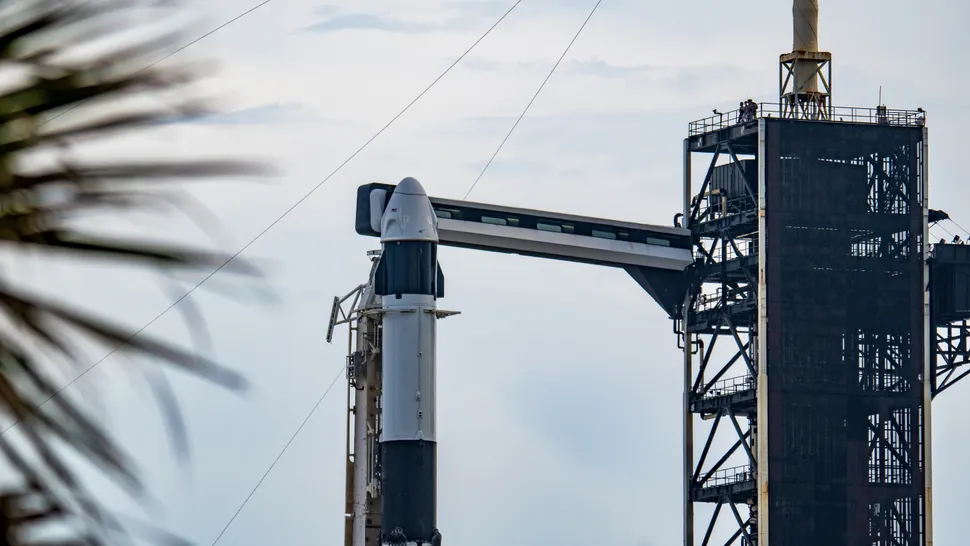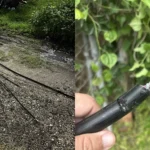Axiom Space’s highly anticipated next astronaut launch, designated Ax-4, is back on the schedule, albeit with a new target date after a series of unexpected delays.
This mission marks Axiom’s fourth crewed flight to the International Space Station (ISS), a vital collaboration in the burgeoning private space sector. Originally slated for a June 11 liftoff aboard a SpaceX Falcon 9 rocket, the launch encountered its first hurdle with the discovery of a liquid oxygen leak in the booster’s first stage, pushing the initial target back by a day.
However, the challenges didn’t end there. Following the rocket issue, an even more critical problem emerged: the detection of another leak, this time at Ax-4’s orbital destination – the International Space Station itself. Cosmonauts aboard the ISS recently identified a “new pressure signature” within the Zvezda, the Russian service module located at the aftmost end of the space station.
While Zvezda has historically experienced minor pressure fluctuations, this new, distinct change prompted an immediate and indefinite delay for the Ax-4 launch, announced by NASA and Axiom on June 12, citing an abundance of caution for crew safety. This article will delve into the details of these delays, the nature of the ISS leak, the corrective actions taken, and the new plan for this pivotal private astronaut mission.
The Zvezda Module Leak: A Lingering Concern
The Zvezda service module has a history of pressure integrity issues, and the latest leak necessitated careful evaluation.
A History of Leaks
The Zvezda module, a critical component of the Russian segment of the ISS, first experienced a pressure leak in 2019. Since then, station operators have been actively managing the issue, implementing periodic pressure checks and employing various methods – what NASA jokingly refers to as the “space equivalent of Flex Tape” – to mitigate the leakage.
These ongoing efforts were seemingly effective, as initial concerns about the leak had subsided. NASA and its partners believed that appropriate repairs had been successfully carried out, leading to a temporary sense of relief regarding the module’s integrity. This past management provided a baseline for understanding the module’s behavior, but the new pressure signature indicated a change in its status.
A New Development and Initial Optimism
Following the most recent repair attempts on the Zvezda module, there was a hopeful sign: pressure in the transfer tunnel had remained stable. This stability was a significant improvement, as previously, the pressure in this area would consistently drop, indicating a leak. NASA, in a June 14 update, cautiously noted that “This could indicate the small leaks have been sealed.”
This initial positive trend suggested that the recent repair work might have finally achieved the desired outcome of sealing the problematic areas within the module. The stability was a critical data point, leading NASA and Axiom to initially announce a new tentative launch date for June 19, demonstrating a growing confidence in the module’s integrity.
Continued Caution and Evaluation
Despite the initial positive observations, NASA maintained a rigorous and cautious approach. The space agency explicitly stated that it was not taking the initial results as definitive proof of a complete repair.
Officials highlighted a critical alternative possibility in their update: “Teams are also considering the stable pressure could be the result of a small amount of air flowing into the transfer tunnel across the hatch seal from the main part of space station.” This means the stable pressure might not be due to a perfect seal, but rather a slow, continuous replenishment of air from another part of the ISS, masking a persistent, albeit small, leak.
To definitively evaluate the situation, teams on the ground devised further tests. They initiated a process of “changing pressure in the transfer tunnel and monitoring over time.” This method allows engineers to precisely evaluate the condition of the transfer tunnel itself and, critically, the integrity of the hatch seal between the space station and the back of Zvezda.
This meticulous approach ensures that no stone is left unturned in verifying the module’s air-tightness before committing to bringing new crew members aboard. The commitment to thorough testing underscores the paramount importance of crew safety in all space operations.
Further Delays and the Final Green Light
NASA’s commitment to safety prompted another adjustment to the launch schedule, leading to the current target date.
Leaning into Uncertainty for Safety
Ultimately, NASA decided to “lean into its uncertainty” regarding the Zvezda leak, prioritizing safety above all else. This meant making a difficult decision to push the Ax-4 launch further, now targeting June 22. As NASA Space Operations explained on social media late Wednesday (June 17), “The change in a targeted launch date provides NASA time to continue evaluating space station operations after recent repair work in the aft (back) most segment of the International Space Station’s Zvezda service module.”
This additional time allows engineers to conduct more comprehensive assessments and ensure that the Zvezda module’s integrity is unequivocally stable before the Ax-4 crew arrives. This decision reflects NASA’s rigorous safety protocols and its dedication to mitigating any potential risks for astronauts.
Falcon 9 Booster Ready
In contrast to the ISS leak, the issues with the SpaceX Falcon 9 first stage have been definitively resolved. The booster assigned to Ax-4, designated B1094, is a relatively new addition to SpaceX’s reusable fleet, having only completed one previous mission. That mission, the Starlink 12-10 launch at the end of April, had apparently shown signs of a liquid oxygen leak during the flight.
During a June 9 press conference, Bill Gerstenmaier, SpaceX’s vice president of build and flight reliability, candidly admitted that technicians “discovered that we had not fully repaired the booster during refurbishment — or we didn’t, actually, didn’t find the leak and didn’t get it corrected.” This transparency is commendable, highlighting the complexities of reusing rocket stages. However, SpaceX swiftly addressed the issue.
The company announced on June 12 that it has completed a new “wet dress rehearsal,” or fueling test, with the rocket. This critical test simulates launch conditions, including fueling the booster with propellants, to ensure all systems are nominal. The successful completion of this test confirms that the launch vehicle is now fully ready for the Ax-4 liftoff, removing any concerns about the rocket’s integrity.
The Mission Ahead: Crew and Scientific Objectives
With the technical hurdles seemingly cleared, the focus now shifts to the Ax-4 mission itself, its crew, and its ambitious scientific agenda.
Launch Details and Crew Commander
Mission operators and the Ax-4 crew are now diligently working towards an early morning June 22 liftoff. The launch is precisely scheduled for 3:42 a.m. EDT (0742 GMT), originating from the iconic Launch Complex-39A at NASA’s Kennedy Space Center in Florida. This historic launchpad has been the starting point for numerous pivotal space missions, adding to the significance of Ax-4.
Commanding the mission will be Peggy Whitson, Axiom’s director of human spaceflight and a revered former NASA astronaut. Whitson is a spaceflight veteran, holding the record for the most cumulative time in space by a U.S. astronaut. Her extensive experience provides invaluable leadership and expertise for this private mission.
The Ax-4 crew will travel aboard a brand-new SpaceX Crew Dragon capsule, perched atop the Falcon 9 rocket, signifying the ongoing advancements in commercial human spaceflight capabilities.
International Crew and Groundbreaking Research
The Ax-4 mission boasts a truly international crew, marking significant firsts for several nations in human spaceflight. The crew consists of:
- Shubhanshu Shukla of India, who will serve as the mission pilot. This will be the first time an astronaut from India has ever visited the ISS, a landmark achievement for the Indian space program.
- Sławosz Uznański-Wiśniewski from Poland, serving as a mission specialist. Uznański’s participation marks another historic first, as he will be the first Polish astronaut to visit the ISS.
- Tibor Kapu from Hungary, also serving as a mission specialist. Kapu’s inclusion represents a significant milestone, making him the first Hungarian astronaut to board the ISS.
This diverse crew underscores the growing global participation in space exploration, with private missions facilitating access for nations previously underrepresented on the ISS. Beyond the pioneering presence of these international astronauts, the Ax-4 mission is set to bring an unprecedented amount of scientific research to the orbital outpost.
The crew is tasked with conducting more than 60 science investigations and STEM (science, technology, engineering, and math) outreach events, exceeding the research payload of any previous Axiom flight. These experiments will cover a wide range of disciplines, contributing valuable data to fields such as human health in space, advanced materials, and fundamental physics.
The mission also aims to inspire the next generation of scientists and engineers through its dedicated STEM outreach initiatives, further expanding the benefits of human spaceflight beyond scientific discovery.
Testament to Perseverance in Space Exploration
The journey to launch for Axiom Space’s Ax-4 mission has been marked by unforeseen challenges, highlighting the inherent complexities and dynamic nature of space operations. From an initial liquid oxygen leak in the SpaceX Falcon 9 booster to a critical pressure anomaly within the ISS Zvezda module, each obstacle has tested the resolve and ingenuity of the involved teams. NASA’s cautious approach and commitment to stringent safety protocols, evidenced by the sequential delays, underscore the paramount importance of crew well-being in every decision.
However, the perseverance of SpaceX, NASA, and Axiom Space has prevailed. With the Falcon 9 booster’s repairs confirmed and the meticulous evaluation of the Zvezda module nearing completion, the new target launch date of June 22 marks a significant step forward. The Ax-4 mission itself is poised to be historic, carrying a diverse international crew from India,
Poland, and Hungary to the ISS for the first time. Their mission will not only contribute immensely to scientific knowledge through over 60 planned investigations but also inspire countless individuals globally through STEM outreach. This upcoming launch is a powerful testament to the collaborative spirit, technical prowess, and unwavering dedication required to push the boundaries of human space exploration, ensuring safe and productive journeys to orbit.








